
Concept explainers
(a)
Interpretation:
The most stable chair conformation of the given molecule is to be drawn in which a
Concept introduction:
According to VSEPR theory,
The most stable chair confirmation of disubstituted cyclohexane is the one in which the larger substituent occupies the equatorial position.
In disubstituted cyclohexane, the substituents which are on the same side are cis to each other whereas substituents which are on the opposite side of the ring are trans to each other. If there is more than one substituent attached, then the conformation in which maximum substituents are in equatorial position is favored and is the most stable. Substituents that are trans to each other in one chair conformation remain trans after the chair flip, whereas substituents that are cis remain cis to each other during the ring flip.
Answer to Problem 4.70P
The most stable conformation of the given molecule is:

Explanation of Solution
The given molecule is:
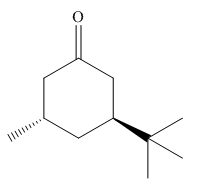
In the given molecule, there is a six member cyclic structure containing carbonyl group as a part of the ring. Thus, it is cyclohexanone. It has two substituents attached which are tertiary butyl group and a methyl group at C3 and C5 carbon atoms of cyclohexanone. Both substituents are trans to each other, as they lie on the opposite side of the ring. The tertiary butyl group is the bulkier substituent on the ring, and it is more stable in an equatorial position. Begin by drawing a chair conformation with a tertiary butyl group in an equatorial position. It is shown by a wedge bond, hence, it must point up in the chair conformation. The tertiary butyl group is pointed up and the methyl group must point down, for them to be trans, hence, the methyl group occupies the axial position as shown below:

If the chair is flipped, the equatorial tertiary butyl group becomes axial. The chair conformation having the bulkier tertiary butyl group in axial position is not stable. Hence, the most stable chair conformation of the given molecule is:

The most stable conformation of the given molecule has one substituent at equatorial position and another at axial position.
Interpretation:
The most stable chair conformation of the given molecule is to be drawn in which a
Concept introduction:
According to VSEPR theory,
The most stable chair confirmation of disubstituted cyclohexane is the one in which the larger substituent occupies equatorial position.
In disubstituted cyclohexane, the substituents which are on the same side are cis to each other whereas substituents which are on the opposite side of the ring are trans to each other. If there is more than one substituent attached, then the conformation in which maximum substituents are in equatorial position is favored and is the most stable. Substituents that are trans to each other in one chair conformation remain trans after the chair flip, whereas substituents that are cis remain cis to each other during the ring flip.
Answer to Problem 4.70P
The most stable conformation of the given molecule is:
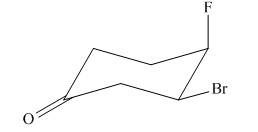
Explanation of Solution
The given molecule is:

In the given molecule, there is a six member cyclic structure containing carbonyl group as a part of the ring. Thus, it is cyclohexanone. It has two substituents attached which are fluorine and bromine atoms at C3 and C4 carbon atoms of cyclohexanone. Both substituents are cis to each other, as they lie on the same side of the ring. Out of the two substituents, bromine atom is the largest substituent on the ring, and it is more stable in an equatorial position. Begin by drawing a chair conformation with bromine atom in equatorial position. It is shown by a wedge bond, hence, it must point up in the chair conformation. The bromine atom is pointed up and the fluorine atom must also point up for them to be cis, hence the fluorine atom occupies an axial position as shown below:

If the chair is flipped, the equatorial bromine atom becomes axial. The chair conformation having the bulkier group in equatorial position is more stable. Hence, the most stable chair conformation of the given molecule is:

The most stable conformation of the given molecule has one substituent at equatorial position and another at axial position.
(c)
Interpretation:
The most stable conformation of the given molecule is to be drawn.
Concept introduction:
According to VSEPR theory,
The most stable chair confirmation of disubstituted cyclohexane is the one in which the larger substituent occupies the equatorial position.
In disubstituted cyclohexane, the substituents which are on the same side are cis to each other whereas substituents which are on the opposite side of the ring are trans to each other. If there is more than one substituent attached, then the conformation in which maximum substituents are in equatorial position is favored and is the most stable. Substituents that are trans to each other in one chair conformation remains trans after the chair flip, whereas substituents that are cis remain cis to each other during the ring flip.
Answer to Problem 4.70P
The most stable conformation of the given molecule is:

Explanation of Solution
The given molecule is:
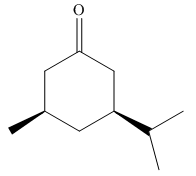
In the given molecule, there is a six member cyclic structure containing carbonyl group as a part of the ring. Thus, it is cyclohexanone. It has two substituents attached which are isopropyl group and methyl group at C3 and C5 carbon atoms of cyclohexanone. Both substituents are cis to each other as they lie on the same side of the ring. The isopropyl group is the largest substituent on the ring, and it is more stable in an equatorial position. Begin by drawing a chair conformation with isopropyl group in the equatorial position. It is shown by a wedge bond, hence, it must point up in the chair conformation. The isopropyl group is pointed up and the methyl group must also point up for them to be cis hence the methyl group goes to another equatorial position as shown below:

If the chair is flipped, both equatorial groups become axial. The chair conformation having the bulkier group in equatorial position is more stable. Hence, the most stable chair conformation of the given molecule is:

The most stable conformation of the given molecule has both substituents in equatorial position.
(d)
Interpretation:
The most stable conformation of the given molecule is to be drawn.
Concept introduction:
According to VSEPR theory,
The most stable chair confirmation of disubstituted cyclohexane is the one in which the larger substituent occupies the equatorial position.
In disubstituted cyclohexane, the substituents which are on the same side are cis to each other whereas substituents which are on the opposite side of the ring are trans to each other. If there is more than one substituent attached, then the conformation in which maximum substituents are in equatorial position is favored and is the most stable. Substituents that are trans to each other in one chair conformation remain trans after the chair flip, whereas substituents that are cis remain cis to each other during the ring flip.
Answer to Problem 4.70P
The most stable conformation of the given molecule is:
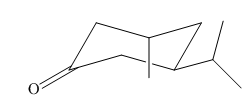
Explanation of Solution
The given molecule is:
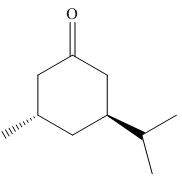
In the given molecule, there is a six member cyclic structure containing carbonyl group as a part of the ring. Thus, it is cyclohexanone. It has two substituents attached which are fluorine and bromine atoms at C3 and C4 carbon atoms of cyclohexanone. Both substituents are trans to each other, as they lie on the opposite side of the ring. Out of the two substituents, the isopropyl group is the largest substituent on the ring, and it is more stable in an equatorial position. Begin by drawing a chair conformation with isopropyl group in equatorial position. It is shown by a wedge bond, hence, it must point up in the chair conformation. The isopropyl group is pointed up and the methyl group must point down for them to be trans, hence the methyl group goes to axial position as shown below:

If the chair is flipped, the equatorial Isopropyl group becomes axial. The chair conformation having the bulkier group in equatorial position is more stable. Hence, the most stable chair conformation of the given molecule is:

The most stable conformation of the given molecule has one substituent at equatorial position and another at axial position.
(e)
Interpretation:
The most stable conformation of the given molecule is to be drawn.
Concept introduction:
According to VSEPR theory,
The most stable chair confirmation of disubstituted cyclohexane is the one in which the larger substituent occupies the equatorial position.
In disubstituted cyclohexane, the substituents which are on the same side are cis to each other whereas substituents which are on the opposite side of the ring are trans to each other. If there is more than one substituent attached, then the conformation in which maximum substituents are in equatorial position is favored and is the most stable. Substituents that are trans to each other in one chair conformation remain trans after the chair flip, whereas substituents that are cis remain cis to each other during the ring flip.
Answer to Problem 4.70P
The most stable conformation of the given molecule is:
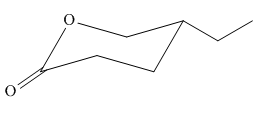
Explanation of Solution
The given molecule is:

In the given molecule, there is a six membered cyclic structure containing ester group as a part of the ring. It has one substituent attached which is a ethyl group not shown by a wedge or dash bond. Thus, the ethyl group can be placed above or below the plane of the ring. The ethyl group is more stable at equatorial position than axial position. Thus, the most stable chair conformation of the given molecule is:

The most stable chair conformation of the given molecule has the bulkier substituent at equatorial position.
Want to see more full solutions like this?
Chapter 4 Solutions
EBK GET READY FOR ORGANIC CHEMISTRY
- ● Biological Macromolecules Naming and drawing cyclic monosaccharides Your answer is incorrect. • Row 1: Your answer is incorrect. Row 3: Your answer is incorrect. • Row 4: Your answer is incorrect. Try again... 0/5 Give the complete common name, including anomer and stereochemistry labels, of the following molecules. You will find helpful information in the ALEKS resource. CH2OH OH OH H H I H OH OH H] H CH2OH H OH ẞ-L-sorbose HOCH2 OH OH H HOCH2 H OH OH H OH H H CH2OH OH H H OH H I- H OH H OH Explanation Recheck W E R % 25 α B Y X & 5 D F G H McGraw Hill LLC. All Rights Reserved. Terms of Use | Pr Parrow_forwardWhat is the missing reactant in this organic reaction? + R -A HO IN + H₂O Specifically, in the drawing area below draw the skeletal ("line") structure of R. If there is more than one reasonable answer, you can draw any one of them. If there is no reasonable answer, check the No answer box under the drawing area. Note for advanced students: you may assume no products other than those shown above are formed. Explanation Check Click and drag to start drawing a structure. © 2025 McGraw Hill LLC. All Rights Reserved. Terms of Use | Privacy Centerarrow_forwardStuc X ctclix ALE X A ALE אן A ALEX Lab (195 X Nut x M Inb x NU X NUT X Unt x + → C www-awu.aleks.com/alekscgi/x/Isl.exe/10_u-lgNslkr7j8P3jH-IQ1g8NUi-mObKa_ZLx2twjEhK7mVG6PulJI006NcKTV37JxMpZuyrVCdQolLAKqp_7U3r1GUD3... New Chrome available: Naomi Question 26 of 39 (4 points) | Question Attempt: 1 of Unlimited Give the IUPAC name. 2,3-dimethylhexane Part: 1/2 Part 2 of 2 Draw the skeletal structure of a constitutional isomer of the alkane above that contains a different number of carbons in its longest chain. Skip Part Check Click and drag to start drawing a structure. 3 Finance headline Q Search mwa Harvard Intensifi... X Save For Later 00 dlo HB Submit Assignment 2025 McGraw Hill LLC. All Rights Reserved. Terms of Use | Privacy Center | Accessibility a 9:11 PM 4/22/2025arrow_forward
- Predict the product of this organic reaction: + NH2 HO A P+ H2O Specifically, in the drawing area below draw the skeletal ("line") structure of P. If there is no reasonable possibility for P, check the No answer box under the drawing area. Click and drag to start drawing a structure. ✓arrow_forward个 Stuc X ctclix ALE X A ALE × A ALE X Lab x (195 × Nut x M Inbx EF 目 → C www-awu.aleks.com/alekscgi/x/Isl.exe/10_u-IgNslkr7j8P3jH-IQ1g8NUi-mObKa_ZLx2twjEhK7mVG6PulJI006NcKTV37JxMpz Chapter 12 HW = Question 27 of 39 (5 points) | Question Attempt: 1 of Unlimited Part: 1/2 Part 2 of 2 Give the IUPAC name. Check 3 50°F Clear ©2025 McGraw Hill L Q Search webp a عالياكarrow_forward个 Stuck x ctc xALE X A ALE × A ALE X Lab x (19: x - G www-awu.aleks.com/alekscgi/x/Isl.exe/10_u-lgNslkr7j8P3jH-1Q1g8NUi-mObka ZLx2twjEhK7mVG6PUUIO06 Chapter 12 HW 三 Question 26 of 39 (4 points) 1 Question Attempt: 1 of Unlimited Answer the following questions about the given alkane. Part: 0 / 2 Part 1 of 2 Give the IUPAC name. Skip Part 2 53°F Clear Check × Q Search hp hp 02arrow_forward
- Calculate the equilibrium constant at 25.0 oC for the following equation. Cd(s) + Sn+2(aq) ↔Cd+2(aq) + Sn(s) Group of answer choices 3.11x104 1.95x1018 9.66x108 1.40x109arrow_forwardWhat is the pH at the cathode for the following cell written in line notation at 25.0 oC with a Ecell = -0.2749 V? Ni(s)|Ni+2(aq, 1.00 M)||H+1(aq, ?M)|H2(g, 1.00 atm)|Pt(s)arrow_forwardCalculate Ecell for a hydrogen fuel cell at 95.0 oC using the following half-reactions with PH2 = 25.0 atm and PO2 = 25.0 atm. O2(g) + 4H+1(aq) + 4e-1 → 2H2O(l) Eo = 1.229 V 2H2(g) → 4H+1(aq) + 4e-1 Eo = 0.00 Varrow_forward
- Calculate Ecell at 25.0 oC using the following half-reactions with [Ag+1] = 0.0100 M and [Sn+2] = 0.0200 M. Ag+1(aq) + 1e-1 Ag(s) Sn+2(aq) + 2e-1 Sn(s)arrow_forwardDone 18:19 www-awu.aleks.com Chapter 12 HW Question 27 of 39 (5 points) | Question Attempt: 1 of Unlimited .. LTE סוי 9 ✓ 20 ✓ 21 × 22 23 24 25 26 27 28 29 30 Answer the following questions about the given alkane. Part: 0 / 2 Part 1 of 2 Classify each carbon atom as a 1º, 2º, 3º, or 4°. Highlight in red any 1° carbons, highlight in blue any 2° carbons. highlight in green any 3° carbons, and leave any 4° carbons unhighlighted. Skip Part Check Save For Later © 2025 McGraw Hill LLC. All Rights Reserved. Terms of Use Privacy Center | Accessibility ☑ คarrow_forward< Done 19:22 www-awu.aleks.com Chapter 12 HW Question 4 of 39 (2 points) | Question Attempt: 5 of Unlimited : .. LTE סוי 1 ✓ 2 ✓ 3 = 4 ✓ 5 ✓ 6 ✓ 7 ✓ 8 ✓ 9 = 10 11 ✓ 12 Consider the molecule (CH3)2CHCH2CHCн for the following questions. Part 1 of 2 Which of the following molecules is/are constitutional isomer(s) to (CH3)2CHCH2CH2CH3? Check all that apply. Part 2 of 2 (CH3),C(CH2)2CH3 CH3 H,C-CH-CH-CH, CH 3 None of the above. ☑ Which of the following molecules is/are identical molecules to (CH3)2CHCH2CH2CH₁₂? Check all that apply. CH3 H,C-CH-CH₂-CH2-CH, CH3(CH2)2CH(CH3)2 CH2-CH2-CH3 HỌC-CH=CH, 乂 ☑ а None of the above Check Save For Later Submit Assignment © 2025 McGraw Hill LLC. All Rights Reserved. Terms of Use | Privacy Center Accessibilityarrow_forward
 Organic Chemistry: A Guided InquiryChemistryISBN:9780618974122Author:Andrei StraumanisPublisher:Cengage Learning
Organic Chemistry: A Guided InquiryChemistryISBN:9780618974122Author:Andrei StraumanisPublisher:Cengage Learning Organic ChemistryChemistryISBN:9781305580350Author:William H. Brown, Brent L. Iverson, Eric Anslyn, Christopher S. FootePublisher:Cengage Learning
Organic ChemistryChemistryISBN:9781305580350Author:William H. Brown, Brent L. Iverson, Eric Anslyn, Christopher S. FootePublisher:Cengage Learning

